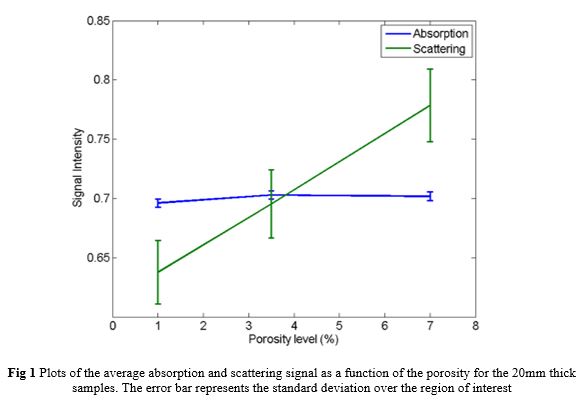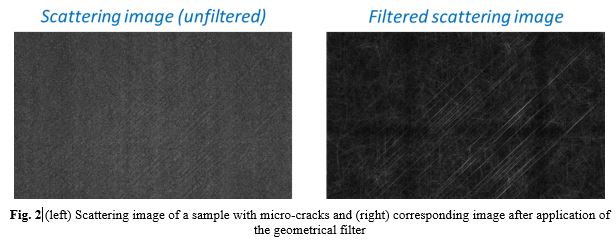The EU-project EVITA (Non-Destructive EValuation, Inspection and Testing of Primary Aeronautical Composite Structures Using Phase Contrast X-Ray Imaging) aims at bringing Grating-based Phase Contrast X-ray imaging technology to Non-Destructive Evaluation and Inspection of advanced primary and/or complex aerospace composite structures. Grating-based Phase Contrast X-Ray Imaging is based on the so-called Talbot-Lau interferometer, which is made of the combination of a standard X-ray apparatus with three transmission gratings as documented in the literature.
This research presents a comparison of two traditional non-destructive techniques (NDT): ultrasonic through transmission (immersed and water jet) and ultrasonic phased-array pulse echo, with the developed phase contrast X-Ray Imaging applied to advanced aerospace carbon fibre reinforced polymer. Typical defects produced during manufacture is examined as part of the testing and validation procedure. The following defects have been identified as being those most likely to be detected more effectively by the Grating-based Phase Contrast X-Ray Imaging process than other state of the art industrial NDT techniques: porosity, foreign objects, cracks, resin rich, cut fibres, and wavy fibres. The introduction of this innovative methodology is expected to provide the aeronautical industry with a reliable and detailed insight of the integrity of thin and thick composite structures as well as of complex geometry ones, such as integrated closed boxes and sandwiches.
The averages of the absorption and scattering images are plotted in Fig 1 as a function of the porosity level, where the standard deviation is represented as the error bar. The signal intensity of the scattering increase linearly with the level of porosity which is not the case with the absorption. With higher magnification, the EVITA system is able to identify the porosity distribution and size. To obtain the information through the thickness, this system has to be coupled with the computed tomography technique.
 Fig. 2 shows the results of the geometrical filter applied to the scattering images of samples with micro-cracks. This is clear that this geometrical filter strongly enhances the detectability and visibility of the elongated micro-cracks. These measurements demonstrate the ability of the EVITA system to detect micro-cracks in composite components. Moreover, the crack shape and density can be obtained.
Fig. 2 shows the results of the geometrical filter applied to the scattering images of samples with micro-cracks. This is clear that this geometrical filter strongly enhances the detectability and visibility of the elongated micro-cracks. These measurements demonstrate the ability of the EVITA system to detect micro-cracks in composite components. Moreover, the crack shape and density can be obtained.
The image fusion algorithm aims at visualising both the filtered structure and the background scattering image (unfiltered) at the same time. In the present case, we decided to display the scattering image as grey levels and to overlap the filtered refraction image with yellow colour. Fig. 3 displays an example of the image fusion for composite samples with different levels of porosity while Fig. 4 shows the example for a composite sample with micro-cracks.
The EVITA demonstrator was presented and its performance was illustrated using two coupon samples with two types of artificial flaws: porosity and cracks. The flaws could be detected and quantified by the EVITA demonstrator with a comparably fast exposure time. The EVITA demonstrator was benchmarked against other state-of-the-art NDI methods. While phased array ultrasonic and through transmission ultrasonic were also able to detect the different porosity level, the ability of the EVITA demonstrator to quantify the level of porosity seems to be promising and will be further investigated in future research. Furthermore, while the detection of cracks can be readily achieved using the EVITA demonstrator and a geometrical filter, no other NDI method used for the benchmarking was able to detect the cracks induced in the structure. In combination with a relative fast exposure time (comparable to phased array ultrasonic), the EVITA demonstrator demonstrated unique features, which can benefit to the non-destructive inspection of lightweight materials such as composites.
The introduction of this innovative methodology is expected to provide the aeronautical industry with a reliable and detailed insight of the integrity of thin and thick composite structures as well as of complex geometry ones, such as integrated closed boxes and sandwiches. By increasing the level of detectability of defects in composite structures, as well as by detecting defects invisible to standard industrial non-destructive testing methodologies, the novel method will play a major role during the whole life cycle of composite components, reducing their inspection cost and increasing their reliability.



